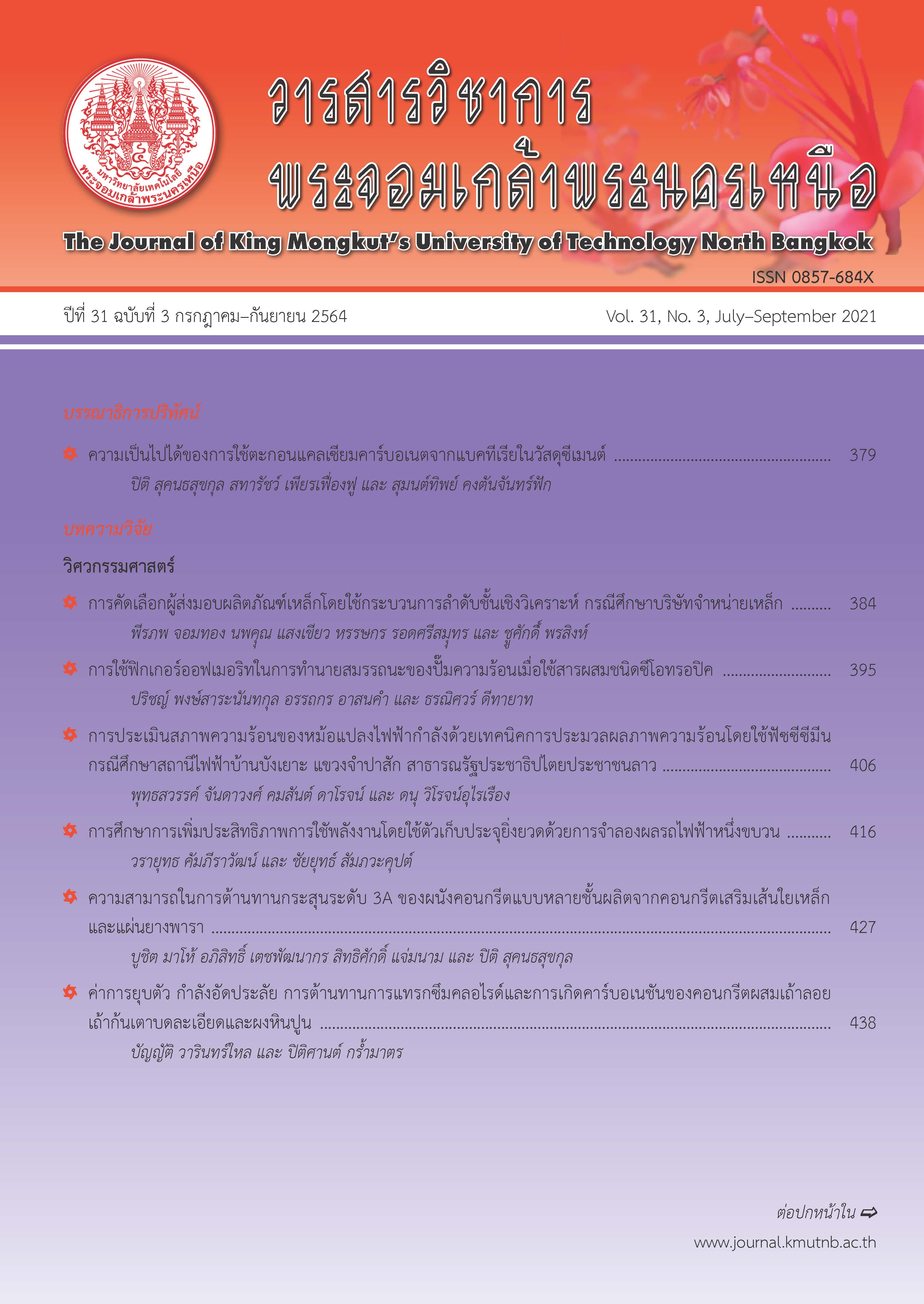Potential Use of Calcium Carbonate Deposits from Bacteria in Cement Materials
Main Article Content
Abstract
ในปัจจุบัน สืบเนื่องมาจากปัญหามลพิษที่รุนแรงทำให้โครงสร้างคอนกรีตส่วนมากเกิดการเสื่อมสภาพเร็วกว่าที่ควรจะเป็น การซ่อมแซมของโครงสร้างคอนกรีตจึงขยับขึ้นมาเป็นหนึ่งในอุตสาหกรรมก่อสร้างที่สำคัญ เมื่อเทียบกับงานก่อสร้างประเภทอื่น โดยวิธีการซ่อมแซมโครงสร้างคอนกรีตรวมถึงการเลือกวัสดุซ่อมนั้นขึ้นกับประเภทของความเสียหายขนาดของความเสียหาย และสาเหตุ สำหรับวัสดุที่ใช้ในการซ่อมแซมการแตกร้าวของคอนกรีต นั้น ในปัจจุบันก็มีมากหลายประเภททั้งที่เป็นวัสดุซีเมนต์เสริมเส้นใย ซีเมนต์ไม่หดตัว และวัสดุประเภทพอลิเมอร์โดยวัสดุซ่อมรอยร้าวเหล่านี้มักมีองค์ประกอบของวัสดุเชื่อมประสาน เช่น ซีเมนต์ อะคริลิก อิพ็อกซี ในสัดส่วนค่อนข้างสูง ซึ่งวัสดุเหล่านี้เป็นวัสดุสังเคราะห์ที่มีคาร์บอนฟุตพริ้นท์จากการผลิตค่อนข้างสูง โดยเฉพาะอย่างยิ่งในตัวของวัสดุซีเมนต์เอง จึงได้มีความพยายามในการพัฒนาวัสดุซ่อมทางเลือกที่มีความเป็นมิตรต่อสภาพแวดล้อมมากขึ้น การใช้ตะกอนแคลเซียมคาร์บอเนตจากแบคทีเรียเองก็เป็นหนึ่งในทางเลือกนั้น บทความนี้เป็นการแนะนำเบื้องต้นถึงแนวทางดังกล่าวโดยจะกล่าวถึงทฤษฎีที่เกี่ยวข้อง และการประยุกต์ใช้บางส่วนที่อยู่ในรูปของงานวิจัย
Article Details
The articles published are the opinion of the author only. The author is responsible for any legal consequences. That may arise from that article.
References
[2] N. Yoshida, E. Higashimura, and Y. Saeki, “Catalytic biomineralization of fluorescent calcite by the thermophilic bacterium Geobacillus thermoglucosidasius,” Applied and Environmental Microbiology, vol. 76, no. 21, pp. 7322–7327, 2010.
[3] Y. Konishi, T. Tsukiyama, K. Ohno, N. Saitoh, T. Nomura, and S. Nagamine, “Intracellular recovery of gold by microbial reduction of AuCl4− ions using the anaerobic bacterium Shewanella algae,” vol. 81, no. 1, pp. 24–29, 2006.
[4] A. Talaiekhozani, A. Keyvanfar, R. Andalib, M. Samadi, A. Shafaghat, H. Kamyab, M. W. Hussin, “Application of Proteus mirabilis and Proteus vulgaris mixture to design self-healing concrete,” Desalination and Water Treatment, vol. 52, no. 19–21, pp. 3623–3630, 2013.
[5] P. Anbu, C.-H. Kang, Y.-J. Shin and J.-S. So, “Formations of calcium carbonate minerals by bacteria and its multiple applications,” SpringerPlus, vol. 5, pp. 250, 2016.
[6] Y. Ç. Erşan, E. Hernandez-Sanabria, N. Boon, and N. de Belie, “Enhanced crack closure performance of microbial mortar through nitrate reduction,” Cement and Concrete Composites, vol. 70, pp. 159–170, 2016.
[7] V. Ivanov, J. Chu, and V. Stabnikov, “Iron- and calcium-based biogrouts for porous soils,” Proceedings of the Institution of Civil Engineers - Construction Materials, vol. 167, no. 1, pp. 36–41, 2014.
[8] M. L. Coleman, D. B. Hedrick, D. R. Lovley, D. C. White, and K. Pye, “Reduction of Fe(III) in sediments by sulphate-reducing bacteria,” Nature, vol. 361, pp. 436–438, 1993.
[9] R. A. Burne and Y.-Y. M. Chen, “Bacterial ureases in infectious diseases,” Microbes and Infection, vol. 2, no. 5, pp. 533–542, 2000.
[10] F. Hammes, N. Boon, J. de Villiers, W. Verstraete, and S. D. Siciliano, “Strain-specific ureolytic microbial calcium carbonate precipitation,” Applied and Environmental Microbiology, vol. 69, no. 8, pp. 4901–4909, 2003.
[11] Y. Fujita, J. L.Taylor, T. L. T. Gresham, M. E. Delwiche, F. S. Colwell, T. L. McLing, and R. W. Smith, “Stimulation of microbial urea hydrolysis in groundwater to enhance calcite precipitation,” Environmental Science and Technology, vol. 42, no. 8, pp. 3025–3032, 2008.
[12] C. Lee, H. Lee, and O. B. Kim, “Biocement fabrication and design application for a sustainable urban area,” Sustainability, vol. 10, no. 11, pp. 1–17, 2018.
[13] N. Chahal, R. Siddique, and A. Rajor, “Influence of bacteria on the compressive strength, water absorption and rapid chloride permeability of fly ash concrete,” Construction and Building Materials, vol. 28, no. 1, pp. 351–356, 2011.
[14] P. Jongvivatsakul, K. Janprasit, P. Nuaklong, W. Pungrasmi, and S. Likitlersuang, “Investigation of the crack healing performance in mortar using microbially induced calcium carbonate precipitation (MICP) method,” Construction and Building Materials, vol. 212, pp. 737–744, 2019.
[15] W. Khaliq and M. B. Ehsan, “Crack healing in concrete using various bio influenced selfhealing techniques,” Construction and Building Materials, vol. 102, pp. 349–357, 2016.

